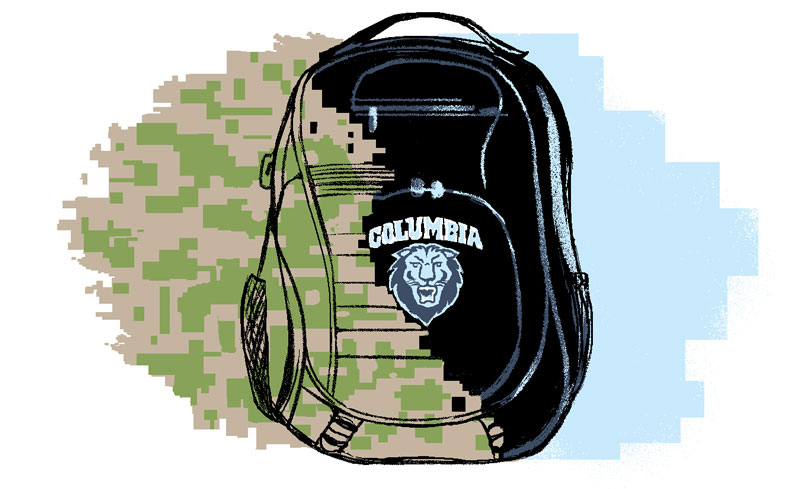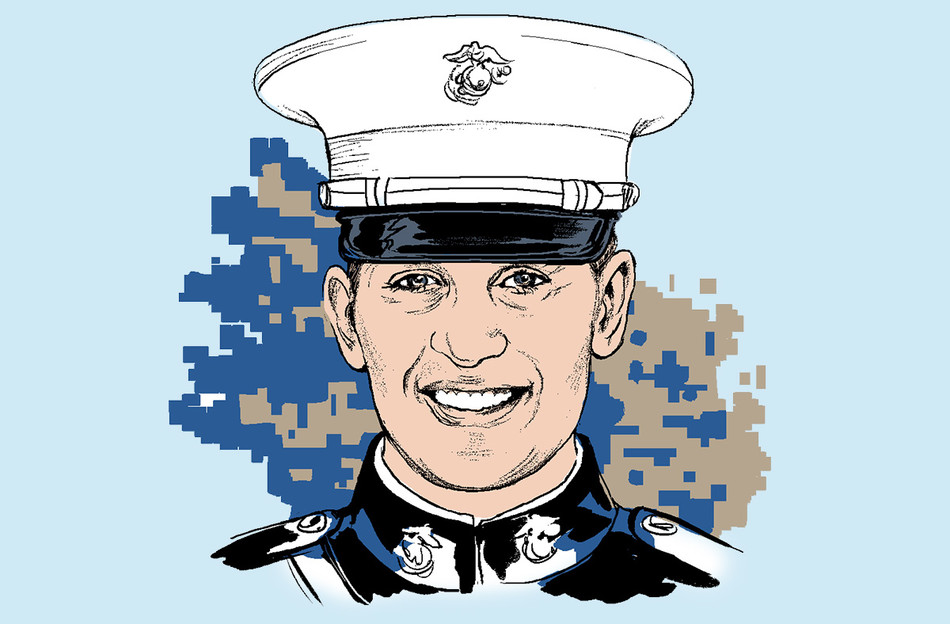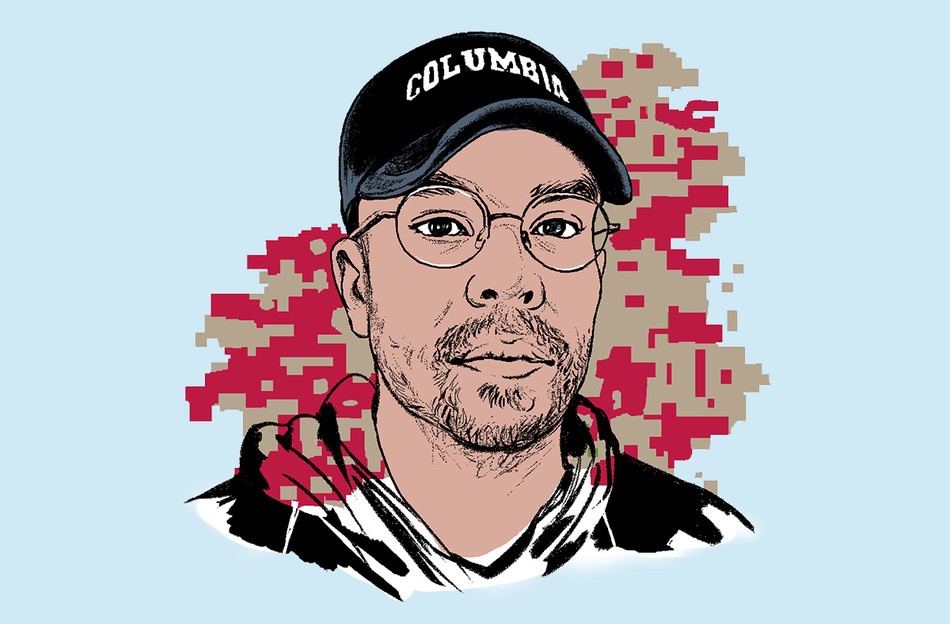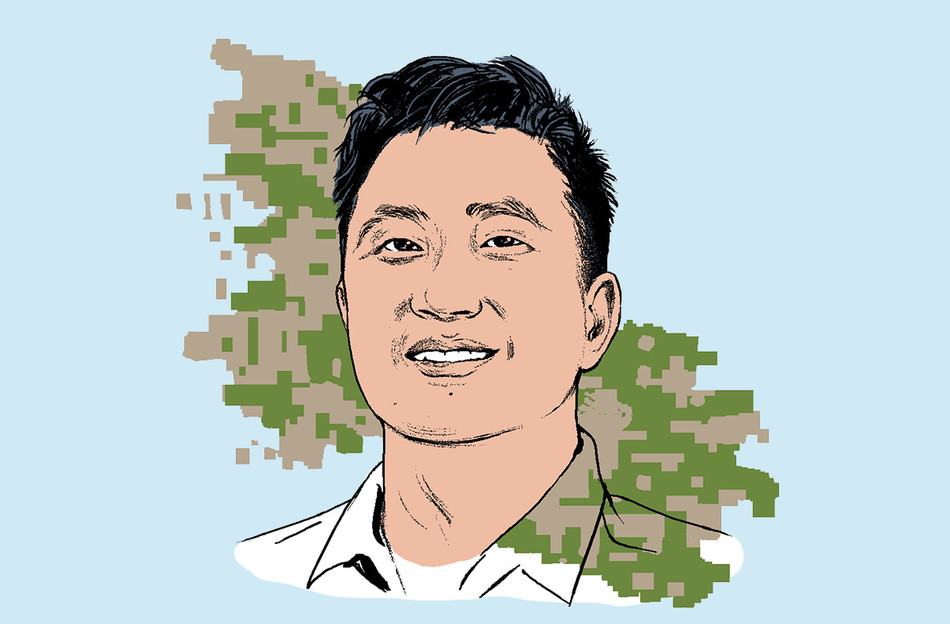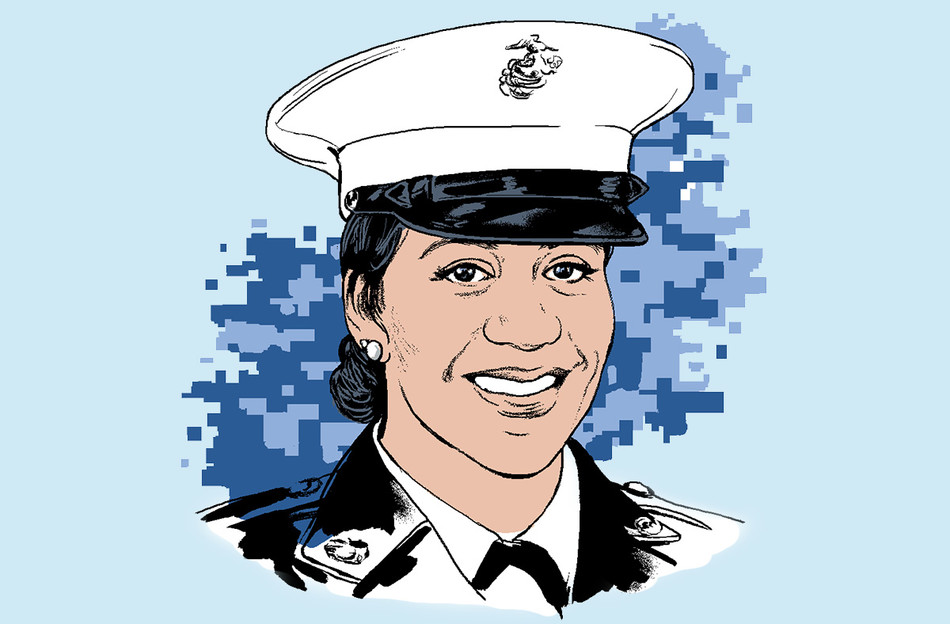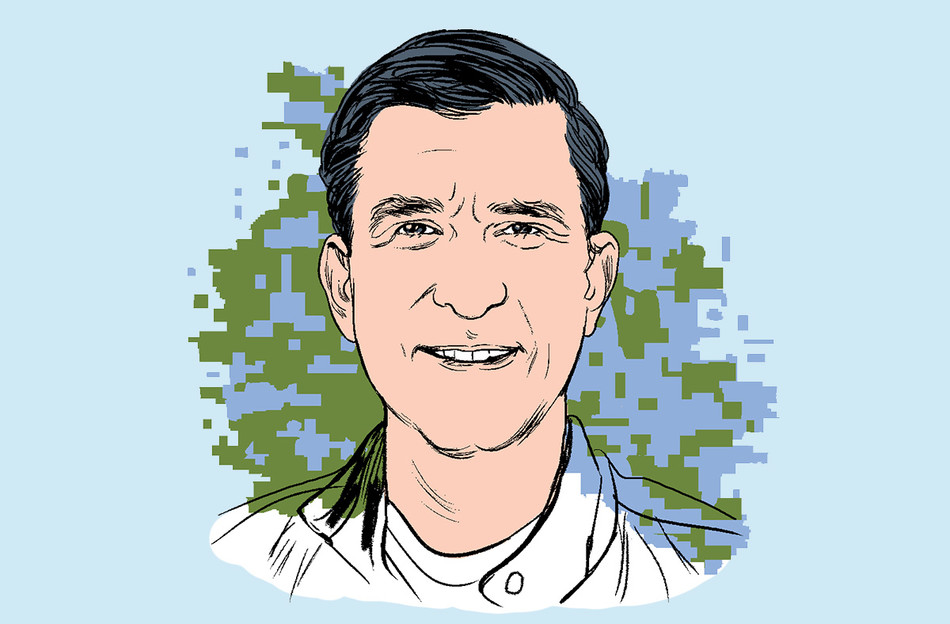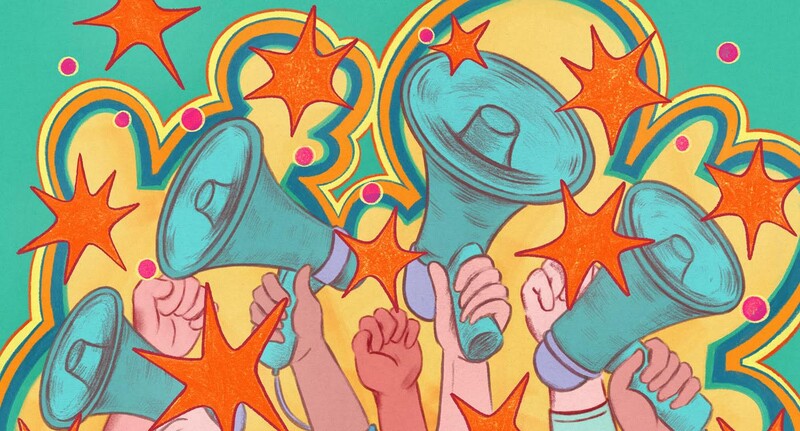Grayson Noyes adjusted the bow tie of his black tuxedo and approached the microphone. It was Veterans Day 2022, and Noyes, a senior at the School of General Studies and president of Military Veterans of Columbia (MilVets), looked out with pride on the five hundred students, faculty, administrators, alumni, and civic leaders who had gathered at Chelsea Piers for the Columbia Military Ball. The crowd, many in brass-buttoned dress uniforms, had come to salute Columbia’s student veterans and to honor President Lee C. Bollinger for his two decades of commitment to veteran education. Noyes, who joined the Marine Corps out of high school, flexed his Core muscles and dropped some Latin: “Here at MilVets we have a motto: Hic sunt leones. Here are lions. The first Roman cartographers wrote the words onto maps to mark uncharted, unknown territories. For most it was a warning; it was a sign of danger. But for everyone here tonight in this room, Hic sunt leones is an invitation, a challenge, and a call to action.”
A few weeks later, in Low Library, Noyes introduced a talk by Carlos Del Toro, the secretary of the Navy. Del Toro, a New York–raised retired Navy officer responsible for nearly a million sailors, Marines, reservists, and civilian personnel, had come to campus to visit the Columbia University Center for Veteran Transition and Integration (CVTI) in its new space in Kent Hall and to present Bollinger with the Navy’s highest civilian honor, the Distinguished Public Service Award. President Bollinger’s leadership was key in bridging the civilian–military divide on campus and bringing a diversity of views to the classroom, the citation read.
In Low, Del Toro argued that a strong Navy is indispensable to national security. He praised Columbia’s Naval Reserve Officers Training Corps program (NROTC) and its midshipmen’s school (1940–45), which during World War II sent twenty-one thousand officers to the Pacific Fleet, and quoted Theodore Roosevelt 1899HON from his days as assistant secretary of the Navy: “We ask for a great Navy; we ask for an armament fit for the nation’s needs, not primarily to fight but to avert fighting.” Del Toro repeated: “To avert fighting.”
A military ball and a warm visit from the seventy-eighth secretary of the Navy might not be the first things people associate with Columbia, a university with a well-known history of antiwar sentiment and skepticism toward the military among students and faculty. Yet today Columbia is considered a model for veteran education and support. There are some seven hundred students on the GI Bill enrolled at Columbia. Around four hundred are undergraduates in the School of General Studies, with another three hundred spread across the graduate schools, mostly at SIPA, the law school, and the business school. The undergrads tend to be enlisted people who have finished their service; the grad students are largely officers (active-duty officers often head to SIPA for two-year graduate degrees on their way to teach at West Point). They come from every branch of the military, from varied backgrounds and viewpoints. They are first-generation college students. They are the children and grandchildren of veterans. They are immigrants. They have flown helicopters, maintained warships, assisted in peacekeeping missions. They have worked as electricians, programmers, translators. Some have seen combat. But for all their differences, these Columbians share an exceptional quality: a deep-seated desire to serve.
For Noyes, as for many student veterans, education is a means to expand his ability to fulfill what he calls “a lifelong need for altruistic and selfless service.” As a Marine in Japan, the Philippines, Mongolia, and South Korea, “I felt I was a force for good in the world,” Noyes says. “But I also recognized that as an enlisted member I could only effect a certain amount of change. I see my Columbia education as a means to effect greater change on a grander scale.”
“The war on terror made us more interesting. I’d been in the Navy for fourteen years, been to the Middle East. Students and a lot of professors really appreciated my perspective.”
How the cultural climate at Columbia tipped from antiwar to pro-veteran — from University President Grayson Kirk and the administration’s botched response to the 1968 student protests against racism and campus-based weapons research to MilVets president Grayson Noyes and Columbia’s reputation as an exemplary veteran-friendly institution — is a story decades in the making, driven by time, history, and a confluence of far-sighted Columbians. First among them is Peter Awn, dean of the School of General Studies from 1997 to 2017. Awn believed that veterans enriched the Columbia classroom and that higher education was vital to cultivating healthy civil–military relations in a democracy. And he often reminded people that many of the school’s first students were World War II veterans coming to Columbia on the GI Bill.
The University has a long tradition of engagement with the military: born from the ashes of the American Revolution (the original King’s College in Lower Manhattan was used as a military hospital during the conflict), Columbia has been represented in every war in the nation’s history. A five-star general and future commander in chief, Dwight D. Eisenhower ’47HON, served as its president, and it graduated another future commander in chief, Barack Obama ’83CC, who ended the military’s discriminatory policy toward gay people known as Don’t Ask, Don’t Tell — which paved the way for the return, after a thirty-year absence, of military-officer training at Columbia.
Peter Awn needed a good marketer. It was 1998, and Awn, a year into his deanship, was eager to recruit a diverse body of students to the School of General Studies. So he asked Curtis Rodgers, a marketing manager at AT&T with a background in higher education, to come to GS and reshape the student population. Rodgers, who is now vice dean of GS, became dean of admissions, and he and Awn began talking about veteran recruitment. Those conversations became more urgent after al-Qaeda militants attacked the US on September 11, 2001. The subsequent military mobilization, first in Afghanistan and eventually in Iraq, portended a large number of returning veterans. “These are folks who decide service is the path to take immediately after high school, or who go to college and find it isn’t the right path at that time,” Rodgers says. “There’s enormous talent and capability in the veteran population, and sometimes military service gives the student the discipline to achieve that potential.”
Awn and Rodgers thought about the role GS ought to play as an undergraduate college created for nontraditional students — ballet dancers, actors, entrepreneurs, and others who take a different road out of high school — and how military skills like teamwork and accomplishing a mission applied naturally to the classroom or the lab. And so they decided to do something radical, especially for the Ivy League: they would engage veterans directly and launch an all-out recruitment effort.
“It’s funny to think back now, but we didn’t know what we were doing,” says Rodgers. “We just knew we needed to figure out how to make connections.” Rodgers cold-called military bases, then visited them. He went to Camp Pendleton in California and Camp Lejeune in North Carolina. He met commanding officers who invited him onto installations to host information sessions and meet exiting service members. The veteran numbers at GS began to rise: twenty, thirty, fifty.
Paul Yates ’05GS, ’08BUS, a cofounder of MilVets who served in the Navy on special boat teams, was one of a handful of veterans on campus when he entered GS in 2002. “The war on terror made us more interesting,” he says. “I’d been in the Navy for fourteen years, been to the Middle East. Students and a lot of professors really appreciated my perspective.”
Then, in 2008, Congress passed the Post-9/11 GI Bill, and President George W. Bush signed it. “That changed everything,” Rodgers says, “because it eliminated the barrier of tuition cost for the first time since the 1944 GI Bill.” Rodgers knew it would have a huge impact on enrollment, and he told Awn that they should participate in a provision of the bill called the Yellow Ribbon Program, through which the US Department of Veterans Affairs (the VA) would match every dollar that Columbia put in, allowing students to cover their tuition and other fees. “Peter said absolutely, and we started to work with the central University folks.”
Columbia’s administration was faced with a decision. Participating in the Yellow Ribbon Program would mean committing money to enrolling student veterans on an activist campus that four decades earlier had voted to eliminate NROTC, citing its inappropriate influence on Columbia’s academic mission, and where the present-day war in Iraq was highly unpopular. “What we knew,” says Rodgers, “was that these were incredibly talented students.” The MilVets president at the time, Peter Kim ’09GS, rallied support from deans and veterans from across the University. “The question became, how can we as community members change the dialogue about the intellectual value that we bring as veterans to the classroom?” says Kim. “It shifted my mindset about how I interacted with fellow veterans on campus, and our role in the Columbia community.” Led by President Bollinger, the administration signed on to the Yellow Ribbon Program, and the veteran population swelled. Says Rodgers, “Peter Awn and I used to remind ourselves that the first time some of our undergraduates would ever meet a veteran might be in a Columbia classroom.”
In Awn’s estimation, there could be no more unlikely advocate for veteran enrollment or the return of NROTC than himself: a gay former Jesuit priest and a professor of religion. “He’d say, ‘If you’d put me out there and said, this is the person who’s going to champion this idea, people would have been shocked,’” Rodgers remembers. “That gave him a lot of credibility. Peter believed society made a mistake in the 1960s and ’70s in how we treated service members, blaming them for policy. Veterans were treated horribly.”
Bringing in veterans was one thing; bringing back NROTC was another. For the Columbia community at large, Don’t Ask, Don’t Tell made it a nonstarter. Then, in 2010, in the lead-up to the termination of the policy, the chairman of the Joint Chiefs of Staff, Mike Mullen, came to Columbia to talk about re-engaging with the military. Columbians grappled again with the fundamental question of whether a military training program like NROTC was compatible with a college campus. Some held that the top-down, ask-no-questions military model was antithetical to academic precepts of free inquiry, while others, like sociology professor emeritus Allan Silver, articulated a vision of mutually flowing benefits between the military and the University, resulting in better military leaders and a stronger civil society. In 2011, after years of upholding the NROTC ban, the University Senate voted again on reinstatement. This time it passed, 55-17-1.
That decision gave even more momentum to recruitment, and the number of veterans on campus surged into the hundreds. Over the next few years, as the needs of veterans evolved and Columbia learned how to meet them, Awn and Rodgers considered how Columbia could share its lessons with the wider veteran community. Working with the administration, they developed a plan, and in 2017, the University established the Center for Veteran Transition and Integration, which offers free online courses and counseling services to veterans nationwide as they move from the military to college. Run through GS and led by Jason Dempsey ’08GSAS, a former infantry officer in Iraq and Afghanistan and an expert on military demographics, CVTI helps veterans figure out the path to higher education and shares tools with community colleges — a frequent first stop for college-bound veterans.
CVTI’s resources are also available to Columbia students, faculty, and staff, bolstering student-veteran services on campus. “When I got to Columbia eight years ago, I’d hear stories of veterans feeling as if they didn’t belong,” says David Keefe ’20SPS, an artist who served as a reconnaissance scout in Iraq and who today is senior assistant dean of student-veteran initiatives at GS. “But now they feel they belong in the classroom and at activities or events, and nonveteran students almost expect that veterans will be there. The campus culture really has changed over time.”
Something else has happened over time — what Keefe calls “a distancing of the student-veteran experience from what the military is primarily designed to do, which is fight wars.
“In peacetime, a lot of people sign up for four to eight years, learn their skills, then transition to the workforce, and it becomes almost a career-building stepping stone,” he says. “So it’s important for us as older veterans to help them understand the destructive capabilities of the military and what it can do, so that we can make better decisions on where the military goes and how it’s deployed, and how we think about and care for veterans. The more we can talk about it, the better the civilian–military relationship.”
That relationship is at the heart of Jason Dempsey’s work. For him, CVTI is a site for reflection on veterans’ place in society and the meaning of citizenship itself. “This isn’t about helping a subpopulation,” he says. “This is about asking, how do we integrate service into all aspects of our lives? How do we deal with those who serve and help them be better citizens? And how do we in turn interact with them so we’re all better citizens?”
In January 2019, Peter Awn was crossing Claremont Avenue at 116th Street when he was struck by an SUV. He later died from his injuries — a wrenching loss to the University community. But his work went on. Lisa Rosen-Metsch ’90GS, a renowned AIDS researcher at Columbia’s Mailman School of Public Health, who succeeded Awn as GS dean in 2017, took up his mantle, strengthening the academic infrastructure for veterans. One of her first acts was to create a leadership roundtable for women veterans, in which successful women from different industries meet with students over lunch for candid discussions. She has watched veterans go on to major companies and pursue advanced degrees in Ivy graduate programs and at Oxford and Cambridge.
At the 2022 Military Ball, it was Rosen-Metsch who presented Bollinger with the Peter J. Awn Lifetime Service Award, commending him for “recognizing that our nation is better served when our very best academic institutions are working to educate the future leaders of our all-volunteer armed forces.”
Amid the tuxes and gowns and dress blues, Bollinger stepped forth to receive the award named for the leading light of the veteran resurgence at Columbia.
“Peter Awn was an incredible being,” Bollinger said. “I never met anyone more enthusiastic about his school and about wanting everybody in the school to succeed. He loved you. He really did. You could feel it every single time you met him.”
Bollinger talked about his own father, a proud World War II veteran who died in 2021 at age ninety-six. Bollinger and his father were very close but were at odds over Vietnam. The son opposed the war and resisted the draft, and the father could never understand the attitudes of students circa 1968. When Bollinger helped to restore NROTC to the Columbia campus, his father took it as “a great victory,” Bollinger said. For himself it was “an act of reconciliation.” In life, said Bollinger, “you want to have that capacity to be open, to reconsider, then to change.”
In his two decades as president, Bollinger accomplished many things, but perhaps none was more remarkable than his having overseen this improbable renaissance. In the ballroom at Chelsea Piers, Bollinger addressed veterans directly. “Thank you for being part of Columbia,” he told them. “But thank you most of all for reflecting and manifesting the values that we embrace.”
Five Veterans Reflect on Their College Experience
A Sea Change
Ebonnie Goodfield enlisted in the Navy right out of high school in 2009 and became an electrician. Raised on Long Island, she loved the Navy — loved traveling the world, loved the sea. She got to know the warship, learned its weapons systems and how to troubleshoot. She met her husband in the Navy, and they had a son. Whenever she went on leave in her uniform, people would thank her.
But when she left the service, something changed.
“Once you take that uniform off and blend back into the civilian population, it seems that it’s the service member who was appreciated, while the veteran is overlooked,” Goodfield says. This is especially the case for women. “Veteran services are tailored to men, older veterans, and women without spouses or children. It almost seemed I was invisible — and so were my problems.”
By 2016, after being discharged for combat disabilities and returning to Long Island, Goodfield was in a bind: she and her husband did not have money for a place to live. Being married with a child, Goodfield wasn’t eligible to enter a shelter and had to rely on family members. She looked for work and eventually landed an administrative job on a nearby air base. Part of her responsibility was to know which universities give the best benefits to potential students. “When I hit upon Columbia, I was looking for a school that could welcome me as a parent and a full-time professional and engage me in a classroom that had older people with a wealth of experience,” she says. “Then I found out about the large veteran population there, and I was sold.”
The moment she walked onto campus, Goodfield was awed. “Low Library to the left, Butler to the right — it was so majestic and grand, so much bigger than me. There is a certain feeling when you’re on a naval ship for the first time: there’s something around you that’s so much bigger than you and that’s going to shape you and you don’t know how, and you don’t know if you’re going to live up to it.”
As Goodfield explored the veteran resources at GS, her confidence grew. She is now vice president of MilVets and co-creator of the Intrapreneurial Leadership Fellows Program, in which five female GS student veterans and five Barnard students work together to learn leadership and problem-solving skills.
Goodfield finds that academic life is on ongoing adventure in self-discovery. “Thinking and learning about what you want — you don’t have that in the military,” she says. “As you transition to education it becomes all about you and who you are, and if you want to succeed, you have to figure out what you’re passionate about, what makes you an individual.”
For Goodfield, that means going on to graduate school. “The education I’m getting here at Columbia is unparalleled — the conversations, the Core — it’s really one of a kind,” she says. “I’m interested in taking it further.”
Doctors Needed
As recently as 2019, there were fewer than a hundred veterans matriculating at US medical schools, according to Chris Bellaire, a former Marine Corps officer who served in the Pacific from 2014 to 2018 and who will graduate from medical school this year. “Medicine is a long training path, and the GI Bill and Yellow Ribbon Program provide significantly less funding for medical education than they do for JD and MBA programs,” Bellaire says. “There are many reasons why there aren’t a lot of veterans in medicine. But it’s very important to have physicians advocate for veteran health.”
Bellaire has always been drawn to caring for others. During his military service, he volunteered at a hospital in Hawaii, near his base. Then, in 2017, while he was deployed in the Philippines, an ISIS-aligned terrorist group laid siege to the city of Marawi, killing hundreds of people and displacing tens of thousands. As part of a Special Operations task force that advised the Filipino government on its counterterrorism operations, Bellaire began to understand the health impacts of poverty, disease, and violence.
After his discharge, Bellaire, who graduated from Princeton, came to Columbia to complete the Postbaccalaureate Premedical Program at GS. “Columbia has a rigorous program, but I wanted that: for med school I needed to transition back into the academic setting, so it was great.” Once at GS, Bellaire bore down. “Columbia is not a golden ticket into med school: you still have to do well on your basic-science coursework, which at Columbia can be challenging. For many veterans, the difficulty of the coursework is a shock.”
While at GS, Bellaire resurrected Columbia MedVets, an organization for student veterans pursuing medicine. Aside from offering community, MedVets holds workshops on applying to medical school and organizes tours to Mount Sinai Medical Center, where Bellaire is now studying orthopedic surgery.
“I want to work with veterans with extremity amputations and traumatic injuries,” he says. “There’s a pretty direct line between the military and medicine. In the military, you serve your country; in medicine, you serve your community. You’re dealing with life and death, and approaching those decisions with humility, compassion, empathy, and competency. For me, med school is a continuation of service.”
A Voice on the Hill
During his two weeks in the psychiatric ward, Richard Brookshire ’16SIPA read a lot of books. It was 2017, and Brookshire, who served as an Army medic from 2009 to 2016, was struggling. Black, gay, closeted, and, as he would soon learn, bipolar, Brookshire had always had an outsider’s view of Army life. He endured sexual harassment even after Don’t Ask, Don’t Tell was repealed while he was in Afghanistan. And he was horrified to see some soldiers at a base in Germany display a fascination with Nazism. “There were microaggressions, but I also had to navigate the seeds of extremism, often excusing it away, because I had to serve alongside these people,” he says.
After returning from Afghanistan, he learned that Trayvon Martin had been killed in Sanford, Florida, where Brookshire had once canvassed for presidential candidate Barack Obama. The news crushed him. He moved to New York, bunked with a friend, and, wanting to finish college, enrolled at Fordham (he hadn’t known about GS). He graduated in 2014, hoping to do development work in Haiti, where his mother was from. But with Haiti unstable and the Black Lives Matter movement ascendant, Brookshire chose to stay in the US. He applied to SIPA and was accepted.
“I’m grateful for the program and got a lot out of it,” he says. “But unlike most people there, I didn’t yet know what I wanted to do.” Even with a master’s degree, he couldn’t find satisfying work. “I was very depressed, very lost.” When Donald Trump became president, Brookshire, tormented by the “double consciousness of being a Black American patriot,” broke down. He sought help at the VA and was “basically turned away.” Despondent, he tried to kill himself and landed in the psych ward at Kings County Hospital in Brooklyn.
One of the books he read while recovering was When Affirmative Action Was White, by Columbia history professor Ira Katznelson ’66CC. “The book covers social-welfare policies under the New Deal and the GI Bill, and two chapters discuss the difficulty Black veterans had in accessing benefits during World War II,” says Brookshire. After his release, he attended a job fair for veterans. Most of them were Black and unemployed or homeless or facing housing insecurity or formerly incarcerated. Brookshire knew he had to act.
He reached out to two Columbia friends: Kyle Bibby ’15SIPA, a Marine Corps captain, and Daniele Anderson ’20GSAS, a former Navy officer. Together they formed the Black Veterans Project, a nonprofit that uses storytelling to educate policymakers and the public about the Black veteran experience. Brookshire then got a job as communications director for Iraq and Afghanistan Veterans of America. There he learned that to lobby lawmakers you need hard data — and there was a glaring lack of reporting on racial disparities among veterans.
Undeterred, Brookshire formed a partnership with a law clinic at Yale, resulting in a massive Freedom of Information Act request for disability claims. The data revealed that in the last twenty years, Black veterans were significantly more likely to be denied benefits than white veterans. In 2020, Brookshire formed a coalition with other Black veteran groups to work for legislative redress. He has since become the main voice for Black vets on the Hill — he testified before Congress last December — and the Black Veterans Project continues to work with its partners to demand compensation for lost benefits.
Few know better than Brookshire how precious those benefits are.
“If it wasn’t for my ability to access the GI Bill to get an education,” he says, “I don’t know where I would be.”
War and Peace
in his first semester at Columbia, in January 2005, Peter Kim ’09GS was hobbling on crutches across College Walk in his Marine Corps uniform when a man stopped him. “I’m a professor,” the man said, “and I know that recruiters aren’t allowed to be here.”
Kim was shocked. “I’m a student,” he said.
He did not explain that he was to appear that day before a military medical board about his reconstructed ankle (thus the uniform). He did not explain how, born in South Korea and raised in New Hyde Park, Long Island, he had enlisted in the Marine Corps Reserve in 1999 at nineteen, to introduce some discipline into his life. Nor did he mention that he was a reservist when the Twin Towers fell, or that in 2003, instead of going to Iraq, he was deployed to the Korean Peninsula because North Korea was testing missiles, and he served as a translator.
He did not describe his deployment, in 2004, to Fallujah, Iraq, where he worked trying to help rebuild Iraqi institutions — the police, the courts — that the US invasion had shattered. He didn’t discuss the particulars of providing convoy support to visiting dignitaries from Washington. In his bewilderment at the professor’s words, all he thought was: Talk about a liberal campus.
Kim had wanted to shed his military past when he got to Columbia, but the encounter on College Walk “really opened my eyes to the reality that that chapter of my life can never fully close,” he says. The alternative was to embrace it, and that’s what he did — eventually.
The hardest part of the transition, he says, wasn’t the occasional unkind remark or even the shift from a military mindset to an academic one. No, the hardest part was being a twenty-seven-year-old freshman. “I thought, ‘Holy crap, these eighteen-year-olds are super smart,” says Kim, who is now an executive at J. P. Morgan. “Forget being part of the military community: how do I be a student?” Once he got more involved with MilVets, he found his footing. “Luckily, we had forward-thinking leaders like Peter Awn and Curtis Rodgers,” says Kim. “Their approach was the same ethos I had to embody in Iraq: win the hearts and minds. Win the hearts of people, of your community, your campus, and you can make change.”
Shortly after Congress passed the Post-9/11 GI Bill in June 2008, Kim became president of MilVets. His goal was to get all of Columbia’s schools to participate in the bill’s Yellow Ribbon Program, in which educational institutions match funds from the VA to pay a student’s way. Kim met with the deans and grad-student veterans across the University. Seventeen schools signed up.
As a senior, Kim also accompanied Rodgers on a trip to Camp Pendleton to talk to potential recruits and made key introductions up the chain of command. Back home, he hosted get-togethers for veterans and nonveterans to help the vets enlarge their social circle and to give traditional students and faculty a new lens through which to see them.
“We weren’t warmongers, and we were trying to dispel that image,” Kim says. “The military is part of us, but it’s not who we are. How, as a veteran, do you break that stigma? Well, you stop drinking by yourself in a lone corner, talking about your time in Iraq, and instead you go have a discussion about Tolstoy.”
Operation Education
Dilia Introini ’17GS, ’19TC desperately wanted to go to college. But her mother was an undocumented immigrant, so Introini did not qualify for financial aid. She had to find another way.
Born in Venezuela, Introini had come with her mother to New York at age six. They lived in Washington Heights and later moved to Rhode Island. One day, during her senior year in high school, she met with a Marine Corps recruiter.
“My mom and I agreed that this was my best shot at pursuing what I really wanted: education, travel, and adventure, and just being a part of something bigger than me,” Introini says. It was 2002, and Introini signed a four-year contract with the Marine Corps. Six months after graduation, she left for boot camp.
Her first duty station was in Okinawa, Japan, and from there she went to Washington and worked at the Pentagon for the assistant commandant of the Marine Corps. She spent nearly eleven years in the Marines. Toward the end, while stationed in South Florida, she wondered what to do next. It was while working out at the gym that she started chatting with a guy who turned out to be a GS alumnus. “He said, ‘You have to go to Columbia,’” Introini recalls. “I’m like, this guy is crazy. I could never get into Columbia.” Then he told her about GS — how it was tailored to veterans. Introini applied and was accepted.
She started GS in the spring of 2014, at age thirty, wanting to study psychology. “At first it was overwhelming,” she says. “In the Marine Corps, everything is a team effort. Someone is always delegating and supervising. To be at Columbia and realize how much work I had do all by myself was daunting.” And, like many student veterans, she suffered from impostor syndrome — the overwhelming sense that you don’t belong.
But she found help at GS, including a course called University Studies, where student veterans discussed how to share a classroom with eighteen-year-olds who seemed to have worked their whole lives to get into the Ivy League. “It was so important for me to hear how similar my experiences were to those around me,” she says. “That course was like therapy.”
Introini graduated cum laude, got her master’s in organizational psychology, and is now a program specialist for the VA.
She wants student veterans who experience imposter syndrome to know they’ve already accomplished a great deal through their service. “It’s hard to realize that the day-to-day things you do in the military are big things,” she says. “They don’t feel like big things — it’s just paperwork, it’s just getting in formation. But the fact you signed on that dotted line and said, ‘Wherever you need me, send me’ — that is a big thing.”
Core Values
The Army didn’t take high-school dropouts, so Paul Yates ’05GS, ’08BUS tried a Navy recruiting center. He had bounced around so much as a kid in California that he rarely finished the school year where he started. His grades suffered, and he dropped out his senior year. But he did like boats.
The Navy didn’t take dropouts either, but the recruiter saw something in him and allowed him to take a test. Yates aced it, and was allowed to enlist in the Navy’s electronics program. He aced that, too, and chose Hawaii as his duty station. For the next few years, he tracked submarines in the Pacific and fixed electronics. Then he heard about “special boat teams” that worked primarily with Navy SEALS. Yates joined and rose to captain.
Once, during his deployment, he was sent to the Seychelles in the Indian Ocean to help train the local coast guard to fend off pirates. At the US embassy he ran into some researchers from Columbia’s Lamont-Doherty Earth Observatory, who had come to take core samples from coral. But their boat was being repaired, and Yates offered to pilot them around. One of the researchers was Kenny Broad ’99TC, who impressed Yates as “extremely smart.” Later, when Yates left the Navy — his knees were damaged from so much bumping around in speedboats — he knew he wanted to go to college. He remembered Broad, and went on the Columbia website to find him. Instead, he found GS.
He entered in 2002, when the few vets on campus could be spotted by their buzzcuts and military-style backpacks. “Even though I considered myself middle-of-the-road politically, coming to Columbia was eye-opening,” Yates says. Some students couldn’t understand why he would choose to risk his life and potentially kill other people, simply because he didn’t know what else to do with himself. “I didn’t think of it that way,” says Yates, “but it’s an interesting question.”
In 2003, Yates, along with Jed Celima ’04GS, Eric Chen ’07GS, Richard Space ’05GS, and Justin White ’05GS, ’07BUS, formed MilVets, wanting to give veterans “an island of community in an ocean of people with different views,” Yates says. MilVets has since evolved into an official student group, focused increasingly on career development. Yates went on to get his MBA and became CFO for a drone startup, which was sold to the defense company FLIR (later bought by Teledyne).
It’s been a long voyage. Yates still recalls reading and discussing The Iliad as an undergrad. “At the end, the Trojan warrior Hector chooses not to stay and defend his wife and son, but goes out to face Achilles, the greatest Greek warrior, alone — essentially, he commits suicide,” Yates says. “It’s told as this glorious event: the hero confronting an insurmountable foe.
“But to me, he quit on his family and his role as a leader. You don’t get to do that in life — you don’t get to go out in a blaze of glory. You live to fight another day.”
This article appears in the Spring/Summer 2023 print edition of Columbia Magazine with the title "Soldier, Sailor, Scholar, Grad."
